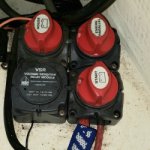Stearmandriver2
New member
Hello all,
I recently closed the deal and brought home a very nice 2006 22 Cruiser... I'm the new caretaker of Notayot.
I'm just trying to understand my electrical system a little better. I have two batteries, and 3 selector switches: Start, House, and Emerg Parallel.

The House and Start switches seem self explanatory, but I'm curious about the Emerg Paralell and primarily, what the proper config is during normal ops. I'm pretty sure the seller said to run with all 3 switches on normally, but I question the word "emerg" on that switch; I'm used to only using things named that way in abnormal operations. I've also read cautions in the C Dory manual about tying the house and starting systems together, which it seems obvious to me that that's what this switch does (but I've certainly been wrong before).
I ran the boat for about an hour that way the other day (all three switches on) and everything seemed (still seems) fine, but I'm having second thoughts now. Can anyone with a similar 2 battery system chime in here?
Motors are a 2006 Honda 90 for a main, with a Tohatsu 9.9 aux.
Thanks!
Joe
I recently closed the deal and brought home a very nice 2006 22 Cruiser... I'm the new caretaker of Notayot.
I'm just trying to understand my electrical system a little better. I have two batteries, and 3 selector switches: Start, House, and Emerg Parallel.

The House and Start switches seem self explanatory, but I'm curious about the Emerg Paralell and primarily, what the proper config is during normal ops. I'm pretty sure the seller said to run with all 3 switches on normally, but I question the word "emerg" on that switch; I'm used to only using things named that way in abnormal operations. I've also read cautions in the C Dory manual about tying the house and starting systems together, which it seems obvious to me that that's what this switch does (but I've certainly been wrong before).
I ran the boat for about an hour that way the other day (all three switches on) and everything seemed (still seems) fine, but I'm having second thoughts now. Can anyone with a similar 2 battery system chime in here?
Motors are a 2006 Honda 90 for a main, with a Tohatsu 9.9 aux.
Thanks!
Joe
